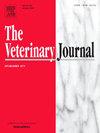A survey of welfare problems associated with transporting horses by road in Germany (2022–2024)
IF 2.3
2区 农林科学
Q1 VETERINARY SCIENCES
引用次数: 0
Abstract
Equine road transport is stressful and associated with an increased risk of behavioral problems, injuries, respiratory and gastrointestinal diseases. This cross-sectional survey-based study aimed to describe transport-related practices and the perception of behavioral and health issues in Germany. The survey targeted horse owners (amateurs and professionals) and obtained demographic details, the participant's experience, frequency and duration of transportation, and behavioral and health problems related to equine transportation. Associations among behavioral and health problems and transport parameters were examined with logistic regression analysis. In total, 432 horse owners participated, but only 59.7 % (258 respondents) completed the questionnaire. Most journeys (72.5 %) were < 2 h in duration and 45.8 % fed hay in transit. One-third of respondents observed behavioral and 42.6 % reported health problems. Diarrhea was most common (33.9 %), followed by injuries (19.3 %), muscle disorders (4 %), respiratory problems, and colic (each 2.4 %). Professionals were less likely to observe diarrhea in transported horses than amateurs (OR 1.04). In single transportation, horses were significantly more likely to show behavioral problems than when transported together (OR 0.53, CI 0.35–0.76, P = 0.001). In conclusion, most of the journeys in Germany were short (<2 h). A high rate of behavioral problems was reported, whereas health issues were considerably less frequently observed. This may be associated with management practices, implementation of safety equipment, shorter travel distances, and favorable climatic conditions in comparison to other studies.
德国公路运输马匹相关福利问题调查(2022-2024)
马的公路运输压力很大,并与行为问题、受伤、呼吸道和胃肠道疾病的风险增加有关。这项基于横断面调查的研究旨在描述德国与交通有关的做法和对行为和健康问题的看法。该调查以马主(业余和专业)为对象,获得了人口统计细节、参与者的经验、运输频率和持续时间,以及与马运输相关的行为和健康问题。用逻辑回归分析检验行为和健康问题与运输参数之间的关系。共有432名马主参与,但只有59.7% %(258名受访者)完成了问卷。大多数旅程(72.5% %)持续时间为<; 2 h, 45.8% %在运输途中吃干草。三分之一的应答者有行为问题,42.6% %的应答者有健康问题。腹泻最常见(33.9 %),其次是损伤(19.3 %)、肌肉紊乱(4 %)、呼吸问题和绞痛(各2.4 %)。专业人员比业余人员更不容易观察到运输马匹腹泻(OR 1.04)。在单独运输中,马比一起运输时更容易出现行为问题(OR 0.53, CI 0.35-0.76, P = 0.001)。总之,在德国,大多数旅行都很短(<2 h)。据报道,行为问题的发生率很高,而健康问题的发生率要低得多。与其他研究相比,这可能与管理实践、安全设备的实施、较短的旅行距离和有利的气候条件有关。
本文章由计算机程序翻译,如有差异,请以英文原文为准。
求助全文
约1分钟内获得全文
求助全文
来源期刊

Veterinary journal
农林科学-兽医学
CiteScore
4.10
自引率
4.50%
发文量
79
审稿时长
40 days
期刊介绍:
The Veterinary Journal (established 1875) publishes worldwide contributions on all aspects of veterinary science and its related subjects. It provides regular book reviews and a short communications section. The journal regularly commissions topical reviews and commentaries on features of major importance. Research areas include infectious diseases, applied biochemistry, parasitology, endocrinology, microbiology, immunology, pathology, pharmacology, physiology, molecular biology, immunogenetics, surgery, ophthalmology, dermatology and oncology.
 求助内容:
求助内容: 应助结果提醒方式:
应助结果提醒方式:


